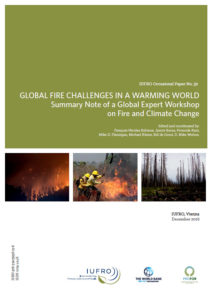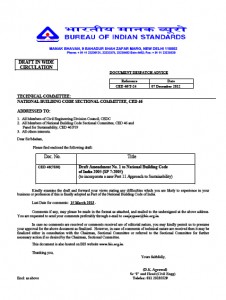2019-04-05 (2021-07-22): Let us imagine, for a moment, that we are in another dimension … The Twilight Zone …
… and that this is a Positive Energy Building, set in a sprawling, diverse, interconnected and flourishing #Woodland with its ecosystems, flora and fauna … an idealized scene … the Sustainability Idyll …

But … is it … ?? What percentage of the world’s population would ever have the opportunity to live this way ???
And … lurking all around this beautiful scene, is an inherent and growing threat to life, property, and those trees, shrubs, and wildlife … #Wildfires / #Bushfires …
The Aim of Sustainable Fire Engineering (#SFE) is to dramatically reduce direct and indirect fire losses in the Human Environment (including the social, built, economic, virtual, and institutional environments) … to protect the Natural Environment … and, within Buildings, to ensure that there is an effective level of Fire Safety for All Users / Occupants, not just for Some, during the full building life cycle.
[ Human Environment: Anywhere there is, or has been, an intrusion by a human being in the Natural Environment. ]
So … how do we reduce direct and indirect fire losses in the Human Environment … and improve its #Resilience ?
.
A recent publication provides a good platform – a benchmark – to begin this serious conversation …
December 2018 … the International Union of Forest Research Organizations (#IUFRO), which is based in Vienna, published Occasional Paper No. 32: ‘GLOBAL FIRE CHALLENGES IN A WARMING WORLD – Summary Note of a Global Expert Workshop on Fire and Climate Change’ …

GLOBAL FIRE CHALLENGES IN A WARMING WORLD – Summary Note of a Global Expert Workshop on Fire and Climate Change (PDF File, 4.72MB)
Executive Summary
Today, catastrophic wildfires are increasingly common across the globe. Recent disasters have attracted media attention and strengthened the perception of wildfires as ‘bad’ events, a plague worsened by climate disruption that has yet to be eradicated. Although it is true that fire has a destructive potential, the reality of global fire activity depicts a much more complex picture in which fire can be a useful, if not necessary, tool for food security and the preservation of cultural landscapes, as well as a an integral element of many ecosystems and their biodiversity.
Global fire activity is shaped by diverse social, economic, and natural drivers influencing the fire environment. The culminating complexity of these factors defines, in turn, the likelihood of a landscape to burn and the potential positive or negative outcomes for communities and ecosystems that can result from a blaze. Although many regions remain understudied, the effects of ongoing climate disruption associated with other planetary changes are already visible, transforming fire activity in ways that are not well understood but are likely to be dramatic, with potential dire consequences for nature, and society in case of #Adaptation failure.
Based on the limited available statistics, there is a growing trend in the cost of wildfires. In addition to human lives that are lost to flames or smoke, and the billions of euros imputable to firefighting and insurance coverage, the growing interest in costs linked to healthcare, business stability, or the provision of ecosystem services such as drinking-water indicates negative economic consequences impacting countries’ GDP and social stability. Attempts to evaluate the future costs of wildfire disasters point at a worsening situation, yet the list of possible social and economic effects is incomplete and the magnitude of envisaged impacts is conservative.
Notwithstanding the difficulties inherent to global climate modelling, there is a scientific consensus on the future increase in the frequency of fire-conducive weather associated with drier ecosystems, a mix that will eventually result in more frequent and intense fire activity. When combined with an ever-growing world population and unsustainable land uses, the conditions leading to fire disaster will only be intensified. Although fire governance has historically advocated for fire suppression, a ‘NO FIRE’ motto is not an option anymore in the new fire reality. Current policies aiming at total fire suppression have been shown to be detrimental and are therefore outdated. The key to wildfire disaster risk reduction in a changing world now lies in learning to live with fire.
Investments in international co-operation, integrated management, local community involvement, cutting-edge technologies, and long-term data collection are critically needed to ensure the future of fire disaster risk mitigation. Moreover, future land development policies must prioritize the protection and the restoration of natural and cultural landscapes that have been degraded by the inappropriate use of fire or, conversely, by historical fire exclusion; keeping a place for fire in forest resource management and landscape restoration has been shown to be a cost-effective and efficient solution to reduce fire hazard.
Overall, synthesis of globally available scientific evidence revealed the following key issues for Landscape Management and Governance:
- Climate Disruption, with longer, hotter, and drier fire seasons, in combination with other environmental changes linked to population growth and unsustainable land-use practices, is contributing to extreme wildfire events that exceed existing fire management capacities. The world is entering a ‘new reality’ that demands new approaches to fire governance.
- Fire is an inherent feature of the Earth System and many ecosystems, including their fauna, are dependent on it for their long-term survival; nevertheless, ongoing changes in global fire activity in terms of location, intensity, severity, and frequency will have immense costs for biodiversity, ecosystem services, human well-being and livelihoods, and national economies – to extents that have yet to be evaluated. Investment in social, economic, and environmental monitoring is therefore urgent, especially in under-studied regions.
- Integrated fire risk reduction is key to adapting to ongoing changes in global fire risk. Future #Sustainable Fire Risk Mitigation demands integrated region-specific approaches based on a clear understanding of fires in context, population awareness and preparedness, fire surveillance and early-warning systems, adaptive suppression strategies, fire-regime restoration, landscape-scale fuel management, changes to many land use practices, and active restoration of landscapes.
- Engagement with local communities, land-owners, businesses and public stakeholders – via multiple tiers of governance – is crucial to restore and maintain landscapes that are biodiverse and functional, respectful of local cultures and identities, economically productive, and above all, fire-resilient.
- People have historically achieved sustainable co-existence with flammable ecosystems and have often used fire as a land-management tool, thereby shaping many modern and long-standing landscapes around the world. Traditional fire knowledge is thus key to adapting to local changes in fire activity, using known techniques for the reduction of dangerous fuel loads, prescribed burning and sustainable landscape management practices.
- Building adaptive capacity to confront fires must be based on knowledge of the natural and cultural roles of fire, how they have shaped our modern landscapes, and their importance in the long-term functioning of socio-ecological systems. Further developments in land-system science, geospatial technologies, and computer modelling will enhance our understanding of the long-term ecological and socio-economic drivers of fire through the widespread collection and distribution of harmonized fire data at the global level. However, creating and sharing such knowledge requires national and international investments in scientific and operational fire science programmes.
- Catastrophic fires are undeniably part of our future. Current scientific estimates are conservative, meaning that changes in fire activity might be worse than anticipated. We have to act now to mitigate catastrophic fires and limit the occurrence of disastrous situations. Given disparities but also similarities in the levels of fire risk around the world, and the capacities to manage it, knowledge and technology transfers through international cooperation will be a paramount factor in learning to live with fire.
This Occasional Paper is the result of a large collaborative effort by fire scientists and practitioners who believe that learning to co-exist with changing fire activity is not only possible but necessary if we, as a global society, are to adapt to climate disruption and keep our natural and cultural landscapes healthy, resilient, and safe for the next generations. The work presented hereafter was developed during, and as follow-up to, the Global Expert Workshop on ‘Fire and Climate Change’ hosted in Vienna, Austria, on 2-4 July 2018. It stresses the diversity and the complexity of the global fire situation, a situation that is evolving, positively or negatively, in unknown proportions due to global environmental changes — with climate disruption being the most acknowledged manifestation.
Conclusion – Learning To Live With Fire
We live on a flammable planet; although not everything is meant to burn, fire cannot be eliminated. Ongoing global climate disruption combined with other planetary changes is leading to more frequent and more extreme fires exposing vulnerable societies, economies, and ecosystems to disaster situations. The recognition of fire activity as a worsening hazard threatening human security is the necessary first step towards international co-operation for the mitigation of disaster risk situations in fire-prone areas.
However, we are not defenceless. Fire scientists in many regions of the world have been developing successful strategies and tools based on cutting-edge technologies for several years. Those are now mature enough to be up-scaled and adapted to other geographic contexts as part of national fire management frameworks. Additionally, integrating existing and future scientific knowledge on climate disruption and changing fire regimes, and systematically collecting long-term data on current and past fire uses will foster better informed decisions, models and enhanced efforts towards Wildfire Disaster Risk Reduction, as well as contribute to the development of Sustainable Anthropocene Fire Regimes.
We hope this paper will be a catalyst for a paradigm shift, so fires are not seen as an enemy to fight but as natural and necessary phenomena, as well as a useful and necessary tool that can often help protect people and nature. It is paramount to revise, fund, and fulfil future management, research, and governance needs if we are, as world citizens, to trigger a societal change that will help us better live with fires.
The information and insights contained in this Occasional Paper connect together to promote the use of several existing solutions to the problem: defining national fire risk reduction frameworks, collecting and analyzing relevant traditional knowledge and biophysical fire data, investing in fire detection and prediction technologies, involving and preparing stakeholders, and improving fire use and landscape management in ways that help control the fuel load and the spread of fire, while limiting GreenHouse Gas (#GHG) emissions and protecting the communities and the landscapes they live in and often depend on.
The Status Quo is no longer an option; it is time to make Integrated Fire Management the rule rather than the exception.
.
.
END



